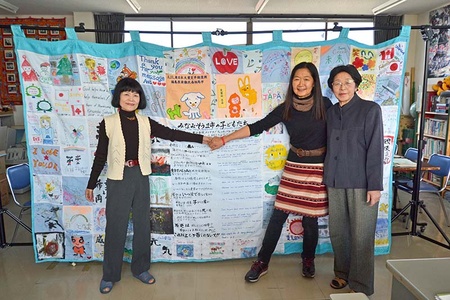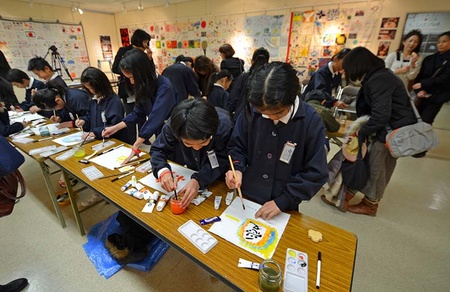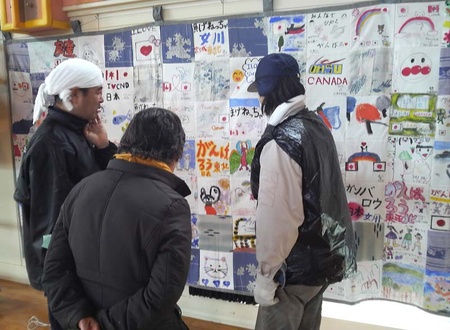Read Part 1 >>
GRANDDAUGHTER INSPIRED PROJECT
Q: Why do you want to bring the letters back to Canada now?
The first cloth letter was made on March 12, 2011 by my granddaughter in Vancouver. From there, it spread across Canada to Halifax, Toronto, Mississauga, Montreal, Winnipeg, Whitehorse, Peace River, Nanaimo, Steveston, Bowen Island, etc.
And, now, 24 months and thousands of letters later, the cloth letters return to where they began!
Q: What are your hopes for this Canadian tour?
My hope is that many Canadians, in many different cities and regions, have the opportunity to see these special and moving messages from the young people.
Q: What are the people in Tohoku still going through two years after 3/11?
Over two years after 3/11, it is estimated that over 320,000 displaced people are still living in cramped temporary housing in Tohoku. People whose homes, businesses, and all their belongings were suddenly lost in one afternoon in 2011.
Nuclear waste from the damaged Fukushima Daiichi nuclear plant continues to contaminate our earth.
The largest number of people living in temporary housing is in Fukushima-ken.
Some of the young people who live about 20 km away from the Fukushima nuclear plant have written cloth letters. They tell us about their fears and dreams in the very moving “Minamisoma, Fukushima Cloth Letters.” The young people from Minamata in Kyushu have joined them.
Q: What is happening on a more personal/family level to the people of Tohoku?
Tohoku can be overwhelming for everyone.
It is a place where simple things give comfort and simple things stress people out.
One day a father, widowed and left with two young school aged children, suddenly broke down in utter defeat. He gave up! Why? Because he didn’t know how to iron his children’s clothes and his kids go to school looking messy. That was the final straw that broke his back.
Generally speaking, the Japanese outwardly seem to be very resilient, diligent, uncomplaining, and patient. This has certainly helped them cope with the disaster conditions, but it has also caused emotional problems and extreme stress over time.
People laugh and say they can’t even have a good argument with their husbands or kids anymore, because the walls of their temporary housing are paper thin.
One woman smiled and said: “But there is still comfort to say or hear, ‘tadaima’, I’m home.”
Q: What kinds of feelings are the survivors sharing with you?
Often the process of making a documentary film is as, or more important than, the finished film itself.
I believe this is the case with “Tohoku no Shingetsu”. It has given so many people the opportunity to talk about their feelings and experiences, sometimes for the first time since 3/11. Often they say thank you for the chance to do this, when it should be the other way around with me thanking them.
A rewarding part of making this film is witnessing people get energized just from talking and sharing their experiences.
One example is an elderly samurai that I met in Minamisoma, 20 km from the Fukushima nuclear plant. The “Namaoi” is the most important cultural event for the area and people have said it is “their soul connection” to life here.
I asked the samurai if he would don his traditional samurai armor and walk down the mainstreet of the deserted town of Odaka. At the beginning he was limping down the empty street, but as he walked further and further, some type of “power” filled his body and he became a samurai warrior again. Even his eyes were filled with a wild strength in the end. He said he felt the change too.
Q: You’ve just finished a large part of filming for your 3/11 doc. How is that project going?
A large part of the location shooting and research is done. We have collected some beautiful footage and moving interviews, and even some dream sequences as time passed.
Canadian cinematographer, Kirk Tougas, who shot Obaachan’s Garden, came to Tohoku for four weeks to film in springtime, while I handled the camerawork alone the rest of the time.
Q: What is the next phase of that project?
It always comes down to how much support and how much budget one has to work with.
Without minimum money, it makes things more difficult, stressful, and slower.
But, I know we are on the right track and will continue to the end.
Q: What is the timeline for completing it?
The next phase is the “summer season” filming in Tohoku which will complete the four seasons.
After that the picture and sound edit. We have a great team of talented film artists helping out.
It is important to finish this film in a timely way for Tohoku. We are aiming for early 2014 completion before the three year mark of the 3/11 disaster.
We go forward.
DRIVING LINDA’S PASSION
Q: Helping the people of Tohoku has been a remarkable effort on your part ever since 3/11 and you organized the fundraising concert at the Queen Elizabeth Theatre in Vancouver. Any thoughts about why this cause means so much to you?
There is no one answer to this.
Maybe it’s because I am just a “Prairie girl” who grew up in a place where the community was built on people helping others who needed help. No questions asked, nothing expected in return.
You just did what you could.
Maybe it’s because I am a mother and grandmother. Or a teacher and humanitarian responding to a place and people that have given me so much over the years.
Maybe it’s because something inside me could not ignore of the horrors of the earthquake and tsunami and nuclear accident that I viewed on different media. It is also a harsh reminder that we in Vancouver and our own families could face a similar disaster one day.
There is comfort when Tohoku people, even little children, say, “If Vancouver has an earthquake, I will come to help.”
Maybe it’s because once you go to Tohoku and experience the Tohoku people, you cannot walk away so easily.
It is all the above and more, that maybe even I am really not aware of.
Q: How much does this have to do with you being Japanese Canadian?
I am not certain, but I am aware that I am somewhat like a bridge between two places and people: the Japanese and Canadians.
Q: What has your own life been like over these past 2 years going back and forth from Onomichi to Tohoku? What kind of obstacles have you had to overcome?
Kinds of obstacles… Obstacles can be overcome: the physical and emotional challenges of being with victims in a disaster area; getting frustrated by some of the unfamiliar customs that govern the behavior of the Japanese; the extreme humidity and heat of the summers; the freezing Tohoku winters without central heating; being so far from my family and friends, especially during holidays like Christmas; living with the uncertainties of the accuracy of the official information. Wondering every time an earthquake starts, when it will stop. And the issue and facts of radiation contamination.
Q: Any personal triumphs you’d like to share?
The wonderful friendships and bonds that grew out from the time there, in Iwate, Miyagi, and Fukushima. We will be friends now for the rest of our lives.
Q: How long are you back in Canada?
Until the next and last phase of filming takes place.
Q: Beyond the Canadian tour, is there a next step for this Cloth Letter exhibition?
Since the beginning of the Cloth Letter project, what comes next has been unpredictable and surprising. Who would have ever known that it would grow so big and still be growing for over two years?
Q: How has this experience affected your thinking about what it means to be Nikkei and Canadian?
My experiences in Tohoku have added to my thinking about what it means and does not mean to be Canadian and Nikkei.
The people in Tohoku saw me as a Canadian. Everywhere I went, they would say the word Canada, but rarely the word “Nikkei”. Canadians are definitely popular and well liked in Tohoku.
I see myself more as a Canadian after all of this, who feels very close and at home in the Japanese culture.

People in Minamisoma. Fukushima join the cloth letters. Their community has been affected by the Fukushima nuclear accident
(For an update on when and where to see this exhibition in your part of Canada, please check the website: www.clothletters.com. If your organization is interested in having an exhibition or workshop, please contact Linda through her website.)
© 2013 Norm Ibuki








